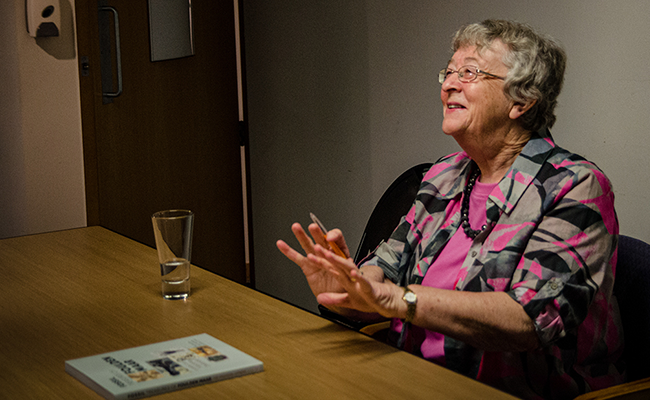 Associate Professor Daphne Lee and her international colleagues Uwe Kaulfuss and John Conran have celebrated the launch of their book Fossil Treasures of Foulden Maar: A window into Miocene Zealandia, published by Otago University Press.
Associate Professor Daphne Lee and her international colleagues Uwe Kaulfuss and John Conran have celebrated the launch of their book Fossil Treasures of Foulden Maar: A window into Miocene Zealandia, published by Otago University Press.
Some 23 million years ago, a violent eruption rocked the landscape close to current-day Middlemarch, and left in its wake a small but deep crater known as a 'maar'.
At that time, Middlemarch wasn't even a twinkle in the Anthropocene's eye, subtropical forest covered the land, and temperatures and atmosphere carbon dioxide levels were significantly higher than today.
Over time the maar filled to become a lake, and the oxygenated upper water and anoxic deeper levels created perfect conditions for the preservation of organic material that fell into its murky depths and slowly sank to the bottom.
It was through this process that, over time, the maar slowly filled and entombed a rich history of life from the ancient rainforest ecosystem in the large deposits of diatomite.
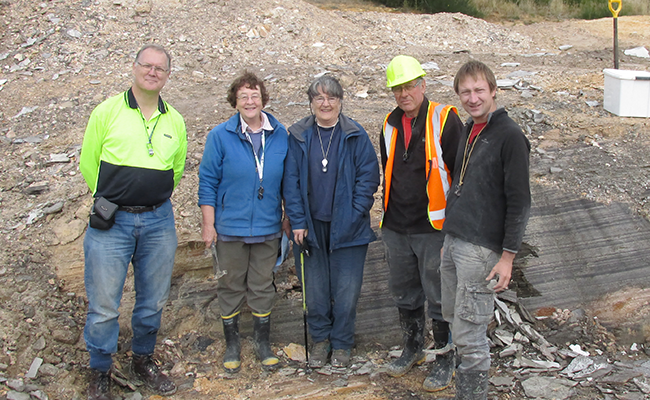 The main Foulden fossil-collecting team, 2017. Left to right: John Conran, Daphne Lee, Jennifer Bannister, Jon Lindqvist, Uwe Kaulfuss (Daphne, John C and Uwe are the co-authors of Fossil Treasures of Foulden Maar).
The main Foulden fossil-collecting team, 2017. Left to right: John Conran, Daphne Lee, Jennifer Bannister, Jon Lindqvist, Uwe Kaulfuss (Daphne, John C and Uwe are the co-authors of Fossil Treasures of Foulden Maar).
Foulden Maar is home to millions of exquisitely preserved fossils including diatoms, pollen, leaves, flowers, fruits, fish, and insects that collectively hold a plethora of information and data about nature's evolutionary past.
These details of Foulden Maar are described by Department of Geology paleontologist and Honorary Associate Professor Daphne Lee, who has had a long association with the scientifically important site and been instrumental in unearthing its treasures and bringing its stories back to life.
Last week, Associate Professor Lee and her international colleagues Uwe Kaulfuss and John Conran, celebrated the launch of their book Fossil Treasures of Foulden Maar: A window into Miocene Zealandia, published by Otago University Press.
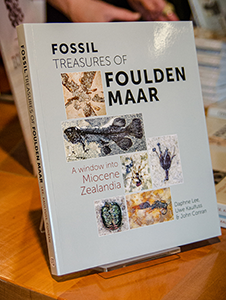 Fossil Treasures of Foulden Maar: A window into Miocene Zealandia
Fossil Treasures of Foulden Maar: A window into Miocene Zealandia
Fossil Treasures of Foulden Maar provides a comprehensive written and visual record of the incredible diversity of fossils collected from the site to date, and includes background information on the site's nationally and globally scientific value.
While Associate Professor Lee and her research colleagues have been unable to access Foulden Maar since 2019 when the land's mining owner Plaman Resources went into receivership, she says there's been plenty of work to continue with and the book has also been a great project.
“It's been a big job as the book is so detailed, and so it's fantastic to see the end product,” Associate Professor Lee says. “Uwe is based in Germany and John in Adelaide and so with the time zone differences the book was worked on for literally 24 hours a day, and the border closures meant it was all completed remotely.”
Full of exquisitely detailed photos and descriptions, the book documents fossils including the oldest known galaxiid fish on Earth, the first freshwater eel in the Southern Hemisphere, and the first fossil spiders found in New Zealand.
Also showcased is a magnificent hand-sized fossil Proteaceae leaf that Associate Professor Lee unearthed at the maar on her birthday, a find she describes as the “most perfect birthday present possible.”
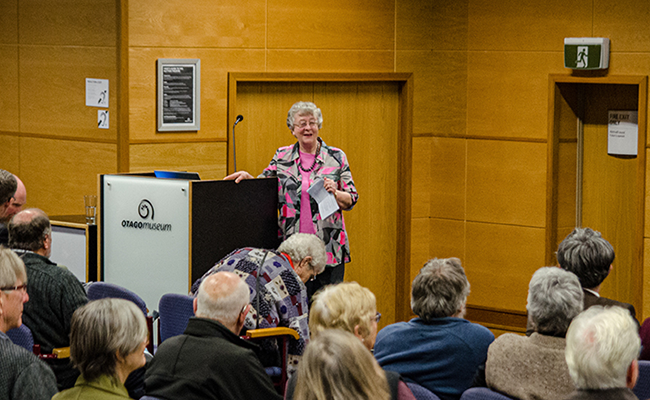 Associate Professor Daphne Lee speaks at the launch of the book.
Associate Professor Daphne Lee speaks at the launch of the book.
The first time Associate Professor Lee came across the term 'geology' was in an after-school geology club during her fourth form at Gore High School. “From school we could see the Hokonui Hills, and along with my rock and shell collections from around Southland, I was riveted by how the teacher brought it all to life,” she says painting a picture of her teenage years.
Although it was unusual to be a woman in the field at the time, Associate Professor Lee forged her own path to study geology at Otago and, apart from 18 months at the University of Cambridge following her doctorate, she has remained on staff since.
The Department of Geology has developed a long association with Foulden Maar since the first postgraduate student completed her MSc thesis on the site in the 1960s. Since then, the Department has undertaken regular fieldtrips to the site, and large numbers of fossils collected from Foulden Maar are now held and catalogued in the Geology Museum.
Associate Professor Lee's research in the Department began with brachiopods and marine invertebrates, and she recollects her first visit to Foulden Maar was sometime in the 1980s. However it wasn't until 2003 that she began and coordinated a dedicated research programme at the site, that to date has resulted in the publication of around 40 papers, and has been largely supported by three Marsden grants since 2009.
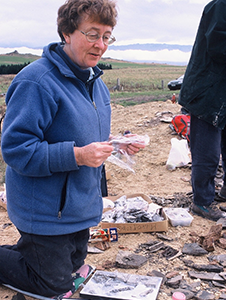 Associate Professor Daphne Lee and the Department of Geology have a long association with Foulden Maar.
Associate Professor Daphne Lee and the Department of Geology have a long association with Foulden Maar.
In addition to the fossils, the geology of the maar has allowed the extraction of high-quality sediment cores allowing a detailed and invaluable record of 100,000 years of environmental and climate data.
Associate Professor Lee reflects on her research journey which has shed new light and knowledge on the natural evolution of southern New Zealand.
“I feel so fortunate to have had the experience in both marine and land-based fossils, that together have informed the geological, ecological, and paleontological history of southern New Zealand over the last 50 million years.
“I have always been driven to explain what is going on in the landscape, and unravelling the story behind why plants and animals are here and where have they come from.”
Sciences Pro-Vice-Chancellor Professor Richard Barker says the Division is immensely proud of Associate Professor Lee's work in bringing the fabulous story of Foulden Maar to the world's attention.
“The work celebrated in this book captures a moment in time when the climate of this part of Zealandia was very different from today,” Professor Barker says.
“At a macro level it gives us a sense of what the future might hold for us climatically, and at a micro level the diatomite itself has given us insight into the coupling of C02 levels and our climate that was as relevant 20 million years ago as it is today.
“There has never been a time when knowing the history of our long ago past has been more important than it is now.”
Associate Professor Lee also credits her husband and ecologist, Professor Bill Lee, who completed his doctorate in the Department of Botany. “We collaborate on many papers and as I work on a different time scale with my research, its certainly helpful having an ecologist in the house as Bill keeps me on the straight and narrow about ecological details.”
Associate Professor Lee also remains positive for a favourable outcome to the ongoing negotiations which will determine future access to the Foulden Maar site, and is looking forward to returning to fieldwork.
“So far we have only just scraped the surface of maar's hidden treasures,” she says. “Every time we go there we uncover new and really exciting fossils that reveal stories which help us to better understand the past, and our future.”
- Kōrero by Guy Frederick (Sciences communications advisor)